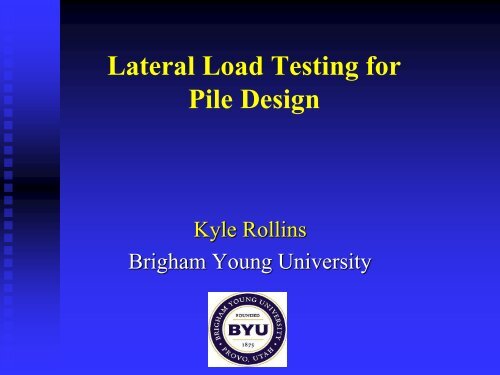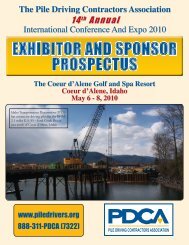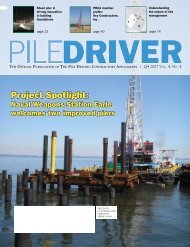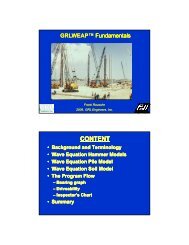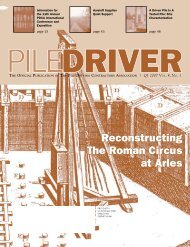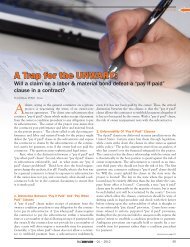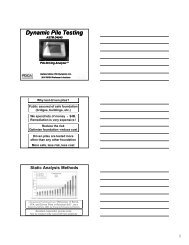Lateral Load Testing for Pile Design
Lateral Load Testing for Pile Design
Lateral Load Testing for Pile Design
You also want an ePaper? Increase the reach of your titles
YUMPU automatically turns print PDFs into web optimized ePapers that Google loves.
<strong>Lateral</strong> <strong>Load</strong> <strong>Testing</strong> <strong>for</strong><br />
<strong>Pile</strong> <strong>Design</strong><br />
Kyle Rollins<br />
Brigham Young University
Wind and Waves in<br />
Hurricanes<br />
Seismic Forces<br />
Ship Impact<br />
Landslides and lateral<br />
spreading in Earthquakes
<strong>Lateral</strong> <strong>Testing</strong><br />
Useful where lateral loads may control design<br />
Main Objective: measure soil resistance of<br />
critical strata<br />
Zone of most influence<br />
Approx top 5 D
Objectives<br />
• Evaluate Soil Resistance<br />
• Confirm <strong>Design</strong> Assumptions<br />
• Improve Reliability<br />
• Reduce Foundation Cost
Stratigraphy & “the big picture”<br />
• Must have good geotech investigation at the<br />
test site and elsewhere<br />
• Consider site variability when interpreting<br />
results & applying to design; site specific<br />
correlations w/ in-situ testing?<br />
• Scourable materials?
Field Test Setup & <strong>Load</strong>ing<br />
• Calibrated Jack, <strong>Load</strong> Cell w/ rot’l bearing<br />
• Long travel jack, displacement transducers<br />
• Strain gages and inclinometers in piles<br />
• Test appropriate stratigraphy!
Single <strong>Pile</strong> <strong>Load</strong> Tests<br />
324 mm OD Steel Pipe <strong>Pile</strong> 600 mm OD Steel Pipe <strong>Pile</strong>
Measurements - Purpose<br />
• Back-fit model to observations<br />
• Evaluate model <strong>for</strong> general soil conditions<br />
across site<br />
• Develop model <strong>for</strong> design (using judgment)<br />
Note: boundary conditions will differ between<br />
test setup & design
Instrumentation & Measurements<br />
• At pile top:<br />
<strong>Load</strong> cell & jack<br />
Displacement<br />
Rotation (use pair of LVDT’s)
I-15 <strong>Lateral</strong> <strong>Load</strong> Test Schematic<br />
Reaction Beam<br />
12.75” Reaction <strong>Pile</strong>s<br />
Swivel-Head End-Platens<br />
LVDT attached to<br />
reference frame<br />
Inclinometer Pipe<br />
12.75” Test <strong>Pile</strong><br />
300 kip <strong>Load</strong> Cell<br />
300 kip Hydraulic Jack<br />
Spacer box
<strong>Load</strong> (kN)<br />
<strong>Load</strong> (kN)<br />
<strong>Load</strong>-Deflection Curve (12.75” Pipe <strong>Pile</strong>)<br />
250<br />
200<br />
150<br />
100<br />
50<br />
Continuous<br />
15th Cycle<br />
Curves<br />
1st Cycle<br />
15th Cycle<br />
0<br />
0 20 40 60 80 100<br />
Deflection (mm)
Instrumentation & Measurements<br />
• Below Grade:<br />
Slope & Displacement<br />
Inclinometer probe<br />
EL-Sensor (downhole inclinometer array)<br />
Shape Array Sensors<br />
Strains
Depth Below Top of <strong>Pile</strong> (ft)<br />
Depth Below Top of <strong>Pile</strong> (ft)<br />
Deflection vs. Depth<br />
Moment vs. Depth<br />
0<br />
Displacement (in)<br />
-1.0 0.0 1.0 2.0 3.0 4.0<br />
0<br />
Moment (kips-ft)<br />
-400 -200 0 200<br />
5<br />
5<br />
10<br />
10<br />
15<br />
10 kips<br />
15<br />
10 kips<br />
20 kips<br />
20 kips<br />
20<br />
40 kips<br />
50 kips<br />
20<br />
40 kips<br />
50 kips<br />
75 kips<br />
75 kips<br />
25<br />
88 kips<br />
95 kips<br />
25<br />
88 kips<br />
95 kips<br />
30<br />
30
Shape Accelerometer Array
Shape Accelerometer Array<br />
Shape Array<br />
Inclinometer Pipe
Depth From Top of Cap (in)<br />
Depth From Top of Cap (in)<br />
Shape Sensor Array<br />
0<br />
Displacement (in)<br />
-0.5 0.0 0.5 1.0 1.5 2.0 2.5 3.0 3.5 4.0<br />
0<br />
Displacement (in)<br />
-0.5 0.0 0.5 1.0 1.5 2.0 2.5 3.0 3.5 4.0<br />
50<br />
50<br />
100<br />
100<br />
150<br />
150<br />
200<br />
200<br />
250<br />
250<br />
300<br />
300<br />
South Array<br />
350<br />
South Inclinometer<br />
350<br />
North Array<br />
400<br />
400<br />
North Inclinometer<br />
450<br />
450<br />
500<br />
500
Strain Gauges<br />
Photos courtesy Applied<br />
Foundation <strong>Testing</strong>
Interpretation of Instrumentation<br />
• M = ε(EI/c)<br />
What is effective I (cracked section)?<br />
What is concrete modulus?<br />
What is precision of strain measurement?
Depth Below Ground Surface (m)<br />
Bending Moment vs Depth<br />
0<br />
Bending Moment (kN-m)<br />
-50 0 50 100 150 200 250<br />
1<br />
2<br />
3<br />
4<br />
5<br />
6<br />
7<br />
8<br />
9<br />
10<br />
11<br />
Deflection<br />
4mm<br />
6mm<br />
13mm<br />
19mm<br />
25mm<br />
38mm<br />
51mm<br />
64mm<br />
76mm<br />
89mm<br />
12
Analysis of <strong>Lateral</strong> <strong>Load</strong> Test Data
<strong>Lateral</strong> <strong>Load</strong> Analysis<br />
H<br />
p<br />
p<br />
p<br />
y<br />
y<br />
Interval<br />
y<br />
2<br />
y<br />
1<br />
Nonlinear<br />
springs<br />
p<br />
p<br />
y<br />
y<br />
y<br />
4<br />
3<br />
y<br />
y<br />
5<br />
After Coduto
Develop <strong>Design</strong> Soil Model<br />
• P-y criteria should reasonably match geotechnical<br />
profile<br />
• Backfit to test results using LPILE or FLPIER<br />
Match load vs displacement response<br />
Match general displacement vs depth and moment vs<br />
depth response<br />
• Nonlinear bending response of the pile can be<br />
important<br />
• Evaluate possible soil variations across site<br />
• Recommend soil parameters <strong>for</strong> design model
Depth below excavated surface (m)<br />
Undrained Strength, s u (kPa)<br />
0 100 200 300<br />
1.34 m<br />
1.07 m<br />
STIFF CLAY<br />
Water Table<br />
s u = 70 kPa 50 = 0.005<br />
k= 136 N/cm3<br />
0.0<br />
1.0<br />
1.65 m<br />
SAND = 36 O k =61 N/cm 3<br />
STIFF CLAY<br />
s u = 105 kPa 50 = 0.005<br />
k= 271 N/cm 3<br />
2.0<br />
3.02 m<br />
3.48 m SAND = 36 O k=61 N/cm 3<br />
4.09 m<br />
STIFF CLAY<br />
s u = 105 kPa 50 = 0.005<br />
k=271.43 N/cm 3<br />
SILTY SAND = 38 O k=61.07 N/cm 3<br />
3.0<br />
4.0<br />
5.15 m<br />
5.0<br />
6.0<br />
Vane Shear Tests<br />
Unconfined Comp. Tests<br />
Avg CPT strength<br />
SOFT CLAY<br />
s u = 35 kPa 50 = 0.01<br />
k= 27 N/cm 3<br />
7.0<br />
8.0<br />
Strength Used in Analysis<br />
9.0<br />
10.0<br />
11.0<br />
12.0
<strong>Load</strong> (kN)<br />
450<br />
Measured & Computed <strong>Load</strong> vs Deflection<br />
400<br />
350<br />
Measured<br />
Computed - LPILE<br />
300<br />
250<br />
200<br />
150<br />
100<br />
50<br />
0<br />
0 5 10 15 20 25 30 35 40 45 50 55<br />
Deflection (mm)
Moment (kN-m)<br />
Computed & Measured Moment vs. <strong>Load</strong><br />
900<br />
800<br />
700<br />
Computed with LPILE<br />
Measured<br />
600<br />
500<br />
400<br />
300<br />
200<br />
100<br />
0<br />
0 100 200 300 400 500<br />
<strong>Load</strong> (kN)
Depth Below Excavated Ground (m)<br />
Computed & Measured<br />
Moment vs Depth<br />
Bending Moment (kN-m)<br />
-100 0 100 200 300 400 500 600 700 800 900<br />
0<br />
1<br />
2<br />
3<br />
4<br />
5<br />
6<br />
7<br />
8<br />
9<br />
133 kN<br />
240 kN<br />
300 kN<br />
414 kN<br />
10<br />
11<br />
12
Use of Model <strong>for</strong> <strong>Design</strong><br />
• Adjust <strong>for</strong> differing pile top boundary<br />
conditions<br />
• Allow <strong>for</strong> scour or other changes<br />
• Allow <strong>for</strong> site variability<br />
• Adjust <strong>for</strong> cyclic loading, group effects, any<br />
other parameters which may not be<br />
reflected in the load test data (liquefaction?)
<strong>Lateral</strong> Statnamic <strong>Load</strong> <strong>Testing</strong><br />
0 to 400 kips in 0.2 seconds<br />
Large Displacement, High Velocity
<strong>Lateral</strong> Statnamic <strong>Testing</strong><br />
• Have Safely Generated <strong>Load</strong>s >1000 tons<br />
• 2000 ton Potential<br />
• <strong>Load</strong> Pulse Can Last Up To 200 ms<br />
• Rate of <strong>Load</strong>ing Similar To Initial Pulse of<br />
Earthquakes, Transient Wind <strong>Load</strong>s, Impact
Schematic of Statnamic Test<br />
Test<br />
Foundation<br />
<strong>Load</strong> Piston<br />
Combustion<br />
Chamber<br />
Statnamic<br />
Sled
Statnamic Test Firing Videos
Downhole Motion Sensors &<br />
Strain Gauges
Equation of Motion<br />
F = F a + F v + F u<br />
= ma + cv + ku<br />
where, F = applied <strong>for</strong>ce (statnamic load cell)<br />
m = mass of the foundation<br />
a = acceleration in g’s<br />
c = damping coefficient<br />
v = velocity<br />
k = static stiffness<br />
u = displacement
<strong>Load</strong> (kN)<br />
Comparison of Dynamic Forces<br />
3000<br />
2500<br />
2000<br />
1500<br />
Fstn<br />
Fa<br />
Fv<br />
Fu<br />
1000<br />
500<br />
0<br />
0.4 0.5 0.6 0.7 0.8 0.9 1<br />
-500<br />
-1000<br />
-1500<br />
-2000<br />
Time (sec)
Damping <strong>for</strong>ce (kN)<br />
<strong>Load</strong> (kN)<br />
Damping<br />
is<br />
the<br />
Difference<br />
3500<br />
3000<br />
2500<br />
2000<br />
1500<br />
1000<br />
500<br />
0<br />
Calculated static load<br />
Measured static load<br />
Statnamic load<br />
0 10 20 30 40<br />
Deflection (mm)<br />
Damping ratios<br />
between 0.3<br />
and 0.5<br />
1400<br />
1200<br />
1000<br />
800<br />
600<br />
400<br />
200<br />
0<br />
0 10 20 30 40<br />
Deflection (mm)
Computation of Equivalent Static Force<br />
Lumped Mass Model<br />
of Drilled Shaft<br />
F s = F stn - ΣM i a i - ΣC i v i
Elevation View of Test Site<br />
3x3 <strong>Pile</strong> Group<br />
High-Speed<br />
Hydraulic Ram<br />
1 m Drilled Shaft<br />
Liquefied Sand<br />
5 m<br />
8 m<br />
Non-Liquefied<br />
Sand
Treasure Island Naval Station<br />
Test Site
Blast Charge Pattern<br />
<strong>Pile</strong> Group<br />
Drilled Shaft<br />
Blast Holes
Ru<br />
Pore Pressure Dissipation Data<br />
1 .2 0<br />
1 .0 0<br />
0 .8 0<br />
0 .6 0<br />
7 .3 m E a st o f A<br />
5 .5 m E a st o f A<br />
4 .3 m E a st o f A<br />
P o int A<br />
3 .2 m W e st o f A<br />
6 .4 m W e st o f A<br />
0 .4 0<br />
0 .2 0<br />
0 .0 0<br />
0 600 1200 1800 2400 3000 3600<br />
T im e [s e c ]
Single <strong>Pile</strong> Test
<strong>Load</strong> (kN)<br />
<strong>Load</strong> vs Deflection Curves <strong>for</strong> Single Pipe <strong>Pile</strong><br />
250<br />
200<br />
150<br />
Non-Liquefied<br />
Liquefied<br />
100<br />
50<br />
0<br />
-50<br />
-100<br />
-50 0 50 100 150 200 250<br />
Displacement (mm)
<strong>Load</strong> (kN)<br />
Ru (%)<br />
100<br />
80<br />
60<br />
40<br />
20<br />
0<br />
-20<br />
-40<br />
200<br />
150<br />
100<br />
0 120 240 360 480 600<br />
Time (sec)<br />
50<br />
0<br />
-50<br />
0 120 240 360 480 600<br />
Time (sec)
Blast Liquefaction Video<br />
(4 <strong>Pile</strong> Group and Shaft)
Depth Below Excavated Ground (m)<br />
Moment Be<strong>for</strong>e & After Liquefaction<br />
-2<br />
Moment (kN-m)<br />
-100 0 100 200 300 400 500<br />
0<br />
2<br />
4<br />
6<br />
8<br />
Be<strong>for</strong>e Liquefaction<br />
10<br />
After Liquefaction<br />
12
Development of p-y Curves<br />
Strain<br />
Curvature<br />
Integrate<br />
Slope<br />
Integrate<br />
Deflection, Y<br />
EI<br />
P-Y curve<br />
Moment<br />
Differentiate<br />
Shear<br />
Differentiate<br />
Distributed<br />
load or<br />
“pressure”, P
Gerber p-y Analysis Routine
Generalized p-y Curves
Computed<br />
vs Measured<br />
Response
Cooper River Bridge<br />
Charleston, South Carolina<br />
Longest Cable-stayed bridge in<br />
North and South America<br />
New Bridge-Completed July 2005
Charleston Statnamic <strong>Testing</strong>
Good Group Behavior
Poor Group Behavior<br />
Angry Mob<br />
Congress<br />
Group IQ = Lowest IQ of anyone in the group
<strong>Pile</strong> Group Interaction<br />
Leading Row <strong>Pile</strong>s<br />
Row 1<br />
Row 2<br />
Trailing Row <strong>Pile</strong>s<br />
Row 3<br />
Direction of<br />
<strong>Load</strong>ing
Horizontal Force/Length, P<br />
P-Multiplier Concept (Brown et al, 1988)<br />
Single <strong>Pile</strong> Curve<br />
P SP<br />
Group <strong>Pile</strong> Curve<br />
P GP = P MULT P SP<br />
Horizontal Displacement, y
P-multipliers from Full-Scale Tests<br />
(Situation in 1998)<br />
Soil Type<br />
(Reference)<br />
Clean Sand<br />
(Brown et al. 1988)<br />
Stiff Clay<br />
(Brown et al. 1987)<br />
Soft Silty Clay<br />
(Meimon et al. 1986)<br />
Front<br />
Row<br />
2 nd<br />
Row<br />
3 rd<br />
Row<br />
0.8 0.4 0.3<br />
0.7 0.5 0.4<br />
0.9 0.5 -<br />
BYU has conducted 11 Full-scale tests over the past 10 years
P-Multiplier<br />
P-multiplier vs. Spacing Curves<br />
1.2<br />
1.0<br />
0.8<br />
0.6<br />
0.4<br />
0.2<br />
0.0<br />
Reese et al (1996)<br />
Reese & Van Impe (2001)<br />
WSDOT (2000)<br />
AASHTO (2000)<br />
US Army (1993)<br />
2 3 4 5 6 7 8<br />
<strong>Pile</strong> Spacing (c-c)/<strong>Pile</strong> Diam.
I-15 <strong>Pile</strong> Group <strong>Testing</strong><br />
• 9 <strong>Pile</strong> Group (324 mm) at 5.6 D Spacing<br />
• 12 <strong>Pile</strong> Group (324 mm) at 4.5 D Spacing<br />
• 15 <strong>Pile</strong> Group (324 mm) at 3.3 D Spacing<br />
• 9 <strong>Pile</strong> Group (600 mm) at 3 D Spacing
15 <strong>Pile</strong> Group at 3.3 D Spacing
9 <strong>Pile</strong> Group at 5.6 D Spacing<br />
Pinned<br />
Connection<br />
LVDT<br />
Tie-Rod<br />
<strong>Load</strong> Cell
Avg. <strong>Pile</strong> <strong>Load</strong> (kN)<br />
9 <strong>Pile</strong> Group at 5.6 D Spacing<br />
250<br />
200<br />
150<br />
100<br />
50<br />
0<br />
Single<br />
Row 1<br />
Row 2<br />
Row 3<br />
0 20 40 60 80<br />
Avg. Group Deflection (mm)
Avg. <strong>Pile</strong> <strong>Load</strong> (kN)<br />
12 <strong>Pile</strong> Group at 4.5 D Spacing<br />
200<br />
150<br />
100<br />
50<br />
0<br />
0 20 40 60 80<br />
Avg. Group Deflection (mm)<br />
Single<br />
Row 1<br />
Row 2<br />
Row 3<br />
Row 4
Avg. <strong>Pile</strong> <strong>Load</strong> (kN)<br />
15 <strong>Pile</strong> Group at 3.3 D Spacing<br />
250<br />
200<br />
150<br />
100<br />
Single<br />
Row 1<br />
Row 2<br />
Row 3<br />
Row 4<br />
Row 5<br />
50<br />
0<br />
0 20 40 60 80 100<br />
Avg. Group Deflection (mm)
Avg. <strong>Pile</strong> <strong>Load</strong> (kN)<br />
9 <strong>Pile</strong> Group at 3 D Spacing<br />
500<br />
400<br />
300<br />
200<br />
100<br />
0<br />
Single<br />
Row 1<br />
Row 2<br />
Row 3<br />
0 20 40 60<br />
Avg. Group Deflection (mm)
P-Multiplier<br />
P-Multiplier<br />
P-multiplier vs Spacing <strong>for</strong> Stiff Clay<br />
(a) Leading Row P-Multipliers<br />
(b) Trailing Row P-Multipliers<br />
1.2<br />
1.0<br />
Reese et al (1996)<br />
1.2<br />
1.0<br />
Reese et al (1996)<br />
0.8<br />
2 ft <strong>Pile</strong><br />
0.8<br />
0.6<br />
0.4<br />
0.2<br />
Brown et al<br />
(1997)<br />
AASHTO (1998)<br />
Stiff Clay-Rollins et al (2003)<br />
0.6<br />
0.4<br />
0.2<br />
2 ft <strong>Pile</strong><br />
2 ft <strong>Pile</strong><br />
Brown et al<br />
(1997)<br />
AASHTO (1998)<br />
Row 2-Stiff Clay Rollins et al (2003)<br />
Rows 3-5-Stiff Clay-Rollins et al (2003)<br />
0.0<br />
2 3 4 5 6 7 8<br />
<strong>Pile</strong> Spacing (c-c)/<strong>Pile</strong> Diam.<br />
0.0<br />
2 3 4 5 6 7 8<br />
<strong>Pile</strong> Spacing (c-c)/<strong>Pile</strong> Diam.<br />
Rollins et al. Oct 2006, ASCE JGGE
P-multiplier Curves vs. Spacing<br />
Rollins et al. Oct 2006, ASCE JGGE<br />
1.2<br />
P-Multiplier, P m<br />
1.0<br />
0.8<br />
0.6<br />
0.4<br />
0.2<br />
0.0<br />
1st Row <strong>Pile</strong>s<br />
2nd Row <strong>Pile</strong>s<br />
3rd or Higher Row <strong>Pile</strong>s<br />
AASHTO<br />
2 3 4 5 6 7 8<br />
<strong>Pile</strong> Spacing (c-c)/<strong>Pile</strong> Diam.
Test<br />
Site<br />
Layout<br />
15 <strong>Pile</strong> Group at<br />
3.9 D Spacing<br />
9 <strong>Pile</strong> Group at<br />
5.6 D Spacing<br />
1.2 m Drilled<br />
Shafts<br />
9 <strong>Pile</strong> Group at<br />
2.8 D Spacing<br />
SLC<br />
Airport<br />
<strong>Pile</strong><br />
Group<br />
Tests
P-Multiplier<br />
P-Multiplier<br />
Group Interaction Reduction Factors<br />
(P-multipliers)<br />
(a) Leading Row P-Multipliers<br />
(b) Trailing Row P-Multipliers<br />
1.2<br />
1.0<br />
Reese et al (1996)<br />
1.2<br />
1.0<br />
Reese et al (1996)<br />
0.8<br />
0.8<br />
0.6<br />
AASHTO (1998)<br />
0.6<br />
AASHTO (1998)<br />
0.4<br />
0.2<br />
0.0<br />
Stiff Clay-Rollins et al (2003)<br />
Soft Clay-This Study<br />
2 3 4 5 6 7 8<br />
<strong>Pile</strong> Spacing (c-c)/<strong>Pile</strong> Diam.<br />
0.4<br />
0.2<br />
0.0<br />
Row 2-Stiff Clay Rollins et al (2003)<br />
Rows 3-5-Stiff Clay-Rollins et al (2003)<br />
Row 2-Soft Clay-This Study<br />
Rows 3-5-Soft Clay-This Study<br />
2 3 4 5 6 7 8<br />
<strong>Pile</strong> Spacing (c-c)/<strong>Pile</strong> Diam.
<strong>Pile</strong> Group <strong>Load</strong> Tests in Sand<br />
3x5 Group at 3.9D Spacing<br />
3x3 Group at 5.65D Spacing<br />
3x3 Group at 3.3D Spacing<br />
2x2 Group at 3.3D Spacing
P-Multiplier<br />
P-Multiplier<br />
P-Multiplier<br />
P-Multipliers vs Spacing (Sand)<br />
(a) 1st Row P-Multipliers<br />
, fm<br />
1.2<br />
1.0<br />
(b) 2nd and 3rd Row P-Multipliers<br />
0.8<br />
1.2<br />
0.6<br />
0.4<br />
0.2<br />
0.0<br />
, fm<br />
1.0<br />
0.8<br />
0.6<br />
0.4<br />
Reese et al (1996)<br />
Full-Scale Tests<br />
Centrifuge Tests<br />
<strong>Design</strong> Line<br />
, fm<br />
AASHTO<br />
Reese et al (1996)<br />
0.8<br />
Full-Scale Tests<br />
2 3 0.2 4 5 6 7 8 Centrifuge Tests<br />
0.6<br />
<strong>Design</strong> Line<br />
<strong>Pile</strong> Spacing 0.0 (c-c)/<strong>Pile</strong> Diam.<br />
AASHTO<br />
2 3 40.4<br />
5 6 7 8<br />
1.2<br />
1.0<br />
<strong>Pile</strong> Spacing 0.2 (c-c)/<strong>Pile</strong> Diam.<br />
0.0<br />
(c) 4th or higher Row P-Multipliers<br />
Reese et al (1996)<br />
Full-Scale Tests<br />
Centrifuge Tests<br />
AASHTO (2000)<br />
2 3 4 5 6 7 8<br />
<strong>Pile</strong> Spacing (c-c)/<strong>Pile</strong> Diam.
Explanation of Variability in Sand<br />
• Natural variability of sand relative to clay<br />
• Sand more influenced by installation<br />
procedure than clays<br />
• Different installation procedures<br />
Jetting<br />
Driven, Open-ended<br />
Sand compacted around previously driven piles<br />
Drilled shafts
Influence of Friction Angle on Group Interaction<br />
Elevation View<br />
45-/2<br />
• Passive failure wedge<br />
inclined at 45-/2.<br />
• As increases the<br />
angle gets smaller and<br />
wedge gets longer.<br />
• Longer wedge causes<br />
more group<br />
interaction.
Influence of Friction Angle on Group Interaction<br />
Plan View<br />
<br />
<br />
• Passive failure wedge<br />
fans out at .<br />
• As increases the<br />
angle gets larger and<br />
wedge gets wider.<br />
• Wider wedge causes<br />
more group<br />
interaction.
P-Multiplier<br />
Influence of Friction Angle on P-multiplier<br />
1.0<br />
Less Group<br />
Interaction<br />
More Group<br />
Interaction<br />
Soft<br />
Clay<br />
Stiff<br />
Clay<br />
Looser<br />
Sand<br />
Denser<br />
Sand<br />
Drained Friction angle, ’
Average <strong>Pile</strong> <strong>Load</strong> (kN)<br />
Post-Liquefaction <strong>Pile</strong> Response<br />
100<br />
80<br />
60<br />
40<br />
20<br />
Single <strong>Pile</strong><br />
Resistance due to<br />
<strong>Pile</strong> alone<br />
Resistance due to<br />
Soil Dilation<br />
0<br />
-20<br />
-40<br />
-60<br />
0 25 50 75 100 125 150 175 200 225 250<br />
Displacement (mm)<br />
P-y curves <strong>for</strong> Liquefied Sand<br />
(ASCE JGGE, Jan 2005)<br />
Built into LPILE/GROUP
Average <strong>Pile</strong> <strong>Load</strong> (kN)<br />
Average <strong>Pile</strong> <strong>Load</strong> (kN)<br />
Post-Liquefaction Group Effects<br />
(10th 200 mm Cycle)<br />
80<br />
100<br />
60<br />
80<br />
40 60<br />
20 40<br />
Lead Row-Group<br />
Single <strong>Pile</strong><br />
Middle<br />
Lead Row-Group<br />
Row-Group<br />
Trail Middle Row-Group<br />
Trail Row-Group<br />
20<br />
0<br />
0<br />
-20<br />
-20<br />
-40<br />
-40<br />
-60<br />
-60<br />
0 25 50 75 100 125 150 175 200 225 250<br />
0 25 50 75 100 125 150 175 200 225 250<br />
Displacement (mm)<br />
Displacement (mm)
Rollins <strong>Pile</strong> Group References<br />
• Rollins, K.M., Olsen, R.J., Egbert, J.J., Jensen, D.H., Olsen, K.G.,<br />
and Garrett, B.H. (2006). “<strong>Pile</strong> Spacing Effects on <strong>Lateral</strong> <strong>Pile</strong><br />
Group Behavior: <strong>Load</strong> Tests.” J. Geotechnical and<br />
Geoenvironmental Engrg., ASCE, Vol. 132, No. 10, October, p.<br />
1262-1271.<br />
• Rollins, K.M., Olsen, K.G., Jensen, D.H, Garrett, B.H., Olsen, R.J.,<br />
and Egbert, J.J. (2006). “<strong>Pile</strong> Spacing Effects on <strong>Lateral</strong> <strong>Pile</strong> Group<br />
Behavior: Analysis.” J. Geotechnical and Geoenvironmental Engrg.,<br />
ASCE, Vol. 132, No. 10, October, p. 1272-1283.<br />
• Rollins, K.M., Lane, J.D., and Gerber, T.M. (2005). “Measured and<br />
Computed <strong>Lateral</strong> Response of a <strong>Pile</strong> Group in Sand.” J.<br />
Geotechnical and Geoenvironmental Engrg, ASCE, Vol. 131, No. 1<br />
Jan., p. 103-114.<br />
• Rollins, K.M., Gerber, T.M., Lane, J.D. and Ash<strong>for</strong>d. S.A. (2005).<br />
“<strong>Lateral</strong> Resistance of a Full-Scale <strong>Pile</strong> Group in Liquefied Sand.”<br />
J. Geotechnical and Geoenvironmental Engrg., ASCE, Vol. 131,<br />
No. 1, p. 115-125.<br />
• Rollins, K.M., Snyder, J.L. and Broderick, R.D. (2005). “Static and<br />
Dynamic <strong>Lateral</strong> Response of a 15 <strong>Pile</strong> Group.” Procs. 16th Intl.<br />
Conf. on Soil Mechanics and Geotech. Engineering, Millpress,<br />
Rotterdam, The Netherlands, Vol. 4, p. 2035-2040.
Brigham Young University Campus<br />
Sponsored by Church of Jesus Christ of Latter Day Saints


